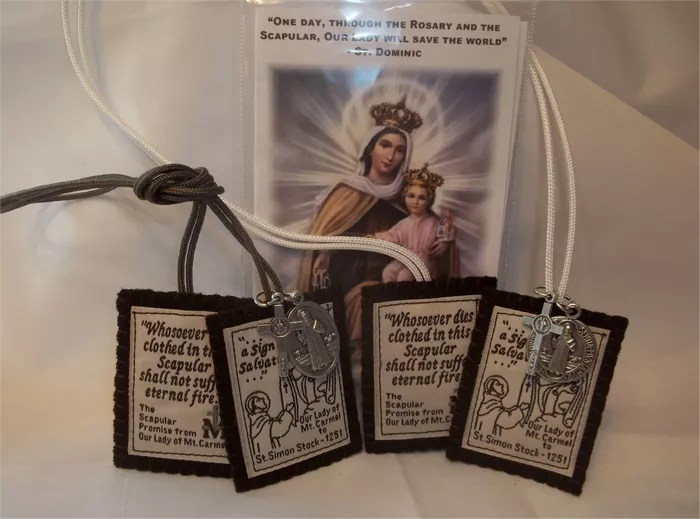The brown scapular, a sacramental within the Catholic Church, holds profound significance for millions of believers worldwide. Often worn as a tangible expression of devotion, its origins, symbolism, and spiritual implications weave a rich tapestry of faith and tradition. In this comprehensive exploration, we delve into the essence of the brown scapular, uncovering its historical roots, theological underpinnings, and enduring relevance in contemporary religious practice.
Historical Origins and Evolution
To understand the brown scapular’s significance, one must trace its historical origins. The scapular finds its roots in the monastic traditions of the early Christian desert fathers, who adopted simple garments as a symbol of their commitment to a life of prayer and asceticism. Over time, the use of the scapular expanded beyond monastic communities to include laypeople seeking to emulate the virtues of these spiritual pioneers.
The brown scapular, specifically, is closely associated with the Carmelite order, a religious community founded in the 12th century on Mount Carmel in the Holy Land. According to tradition, the Blessed Virgin Mary appeared to Saint Simon Stock, the Carmelite prior general, in the 13th century, presenting him with the scapular as a sign of her maternal protection and the privilege of membership in the Carmelite family.
Symbolism and Spiritual Significance
Central to understanding the brown scapular is grasping its symbolism and spiritual significance. The scapular consists of two small pieces of cloth, typically brown in color, connected by strings and worn over the shoulders, with one piece hanging in front and the other in the back. This garment symbolizes the yoke of Christ, reminding the wearer of their commitment to live according to the Gospel teachings.
Moreover, the brown scapular is imbued with Marian symbolism, signifying devotion to the Blessed Virgin Mary. For Catholics, Mary holds a special place as the Mother of God and a model of faithfulness and obedience. Wearing the brown scapular is seen as a way to express devotion to Mary and to seek her intercession in times of need.
Theological Foundation and Promises
The brown scapular is not merely a piece of cloth; it is rooted in theological doctrine and accompanied by promises believed to be granted by the Virgin Mary to those who wear it devoutly. These promises, often referred to as the “Sabbatine Privilege,” are based on medieval legends and papal decrees, asserting that Mary will intercede for the souls of the faithful who wear the scapular with piety and observe certain devotional practices, such as regular prayer and chastity according to one’s state of life.
While the Sabbatine Privilege is not officially defined doctrine and has been subject to theological debate, it remains a cherished belief among many Catholics, inspiring them to embrace the brown scapular as a tangible expression of their faith and a source of spiritual protection.
Devotion and Practice
The brown scapular is more than a religious accessory; it is a tangible expression of devotion and a catalyst for spiritual growth. For many believers, wearing the scapular serves as a constant reminder of their commitment to follow Christ and emulate the virtues of the Blessed Virgin Mary.
Devotional practices associated with the brown scapular vary but often include the daily recitation of prayers such as the Rosary or the Little Office of the Blessed Virgin Mary. Additionally, some wearers participate in special ceremonies, such as the enrollment in the Confraternity of the Brown Scapular, which formalizes their commitment to the Marian devotion associated with the scapular.
Contemporary Relevance and Popular Devotion
In an age marked by rapid social change and shifting cultural norms, the brown scapular endures as a symbol of timeless faith and devotion. While its popularity may have waned in some quarters, particularly in Western societies influenced by secularism, it continues to hold sway among devout Catholics and those drawn to its spiritual promises and symbolism.
Furthermore, the brown scapular has found renewed relevance in recent years, as interest in traditional forms of spirituality experiences a resurgence. Many Catholics, particularly young adults, are rediscovering the richness of their religious heritage and embracing practices such as wearing the scapular as a way to deepen their faith and foster a deeper connection to the Church’s traditions.
Conclusion
The brown scapular stands as a tangible expression of faith, devotion, and commitment within the Catholic tradition. Its historical origins, theological significance, and enduring popularity make it a cherished sacramental for millions of believers worldwide. As Catholics continue to seek ways to deepen their spiritual lives and draw closer to God, the brown scapular remains a beacon of hope and a symbol of Mary’s maternal care and protection.

